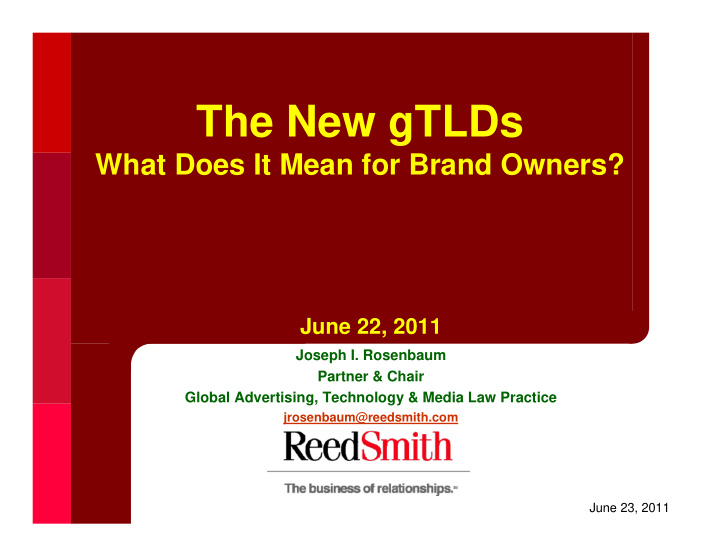



The New gTLDs What Does It Mean for Brand Owners? June 22, 2011 Joseph I. Rosenbaum Partner & Chair Global Advertising, Technology & Media Law Practice jrosenbaum@reedsmith.com June 23, 2011
Whois? ICANN International Corporation for Assigned Names and Numbers Not-for-profit California corporation created in 1998 by U.S. Department of Commerce Allocation/assignment of domain names & IP addresses “promote competition and choice in the domain-name marketplace ….” Operation & evolution of DNS root name server system
What is a Domain Name? Easy-to-remember name vs. IP numerical address www.reedsmith.com = 10.141.192.31 DNS (Domain Name System) •Country Code TLDs (e.g., .us, .uk, .ca, .de, .br, etc.): ISO 3166, Codes for the representation of names of countries and their subdivisions (Parts 1, 2 and 3) is the commonly accepted International Standard since 1974. •Generic TLDs (e.g., .com, .net, .org, .biz, .info, etc.) •Sponsored TLDs (e.g., .xxx, .aero, .coop, .mobi, .jobs) •Second Level Domain Names reedsmith .com yourbrand .com New gTLD Scheme: Not .com but .reedsmith gTLD = .almostanythingyoucanthinkof yourname.almostanythingyoucanthinkof yourbrands.almostanythingyoucanthinkof yourproducts.almostanythingyoucanthinkof Email: joe@reedsmithny.advertisingtechnologyandmedialaw
Distinctive: Address or Name? Domain Name - Just An Address? To Administrators: RFC 1591 (March 1994) “ 4. Rights to Names 1) Names and Trademarks In case of a dispute between domain name registrants as to the rights to a particular name, the registration authority shall have no role or responsibility other than to provide the contact information to both parties. The registration of a domain name does not have any Trademark status. It is up to the requestor to be sure he is not violating anyone else's Trademark. To Brand Owners: Domains Are Property With Rights Trademarks, Cybersquatting, Typosquatting
Enforcement Anticybersquatting Consumer Protection Act (ACPA) , 15 U.S.C. § 1125(d) : U.S. law enacted in 1999, establishing a cause of action for registering, trafficking in, or using a domain name confusingly similar to, or dilutive of, a trademark or personal name Uniform Domain-Name Dispute-Resolution Policy ( UDRP ) is a process established by the Internet Corporation for Assigned Names and Numbers (ICANN) for the resolution of disputes regarding the registration of internet domain names. To succeed in a UDRP proceeding, the complainant must establish : The domain name is identical or confusingly similar to a trademark or service mark in which the complainant has rights; The registrant does not have any rights or legitimate interests in the domain name; and The registrant registered the domain name and is using it in "bad faith."
Application: Where Do I Start? http://www.icann.org/en/topics/new-gtlds/rfp-clean-30may11-en.pdf
Application: Initial Evaluation Review of applicant (initial evaluation) • Technical, operational, financial capability to operate a registry. • String review (initial evaluation) • Confusion with existing, reserved, applied for TLDs • Compliance with technical considerations (e.g., use, order and number of characters) • Overlap with geographic terms
Costs and Fees Application Costs - ICANN • Application fee: $185,000; $5,000 initial deposit • Withdrawal and refund • Annual recurring registration fee $25,000 + variable amount after registry reaches 50,000 domains • Possible other fees • Extended evaluation on security/stability issues: $50,000 • Dispute resolution fees 5k to 125k, depending on proceeding Other Application-Related Fees • Consultant & Legal Fees • Registry set up and maintenance • Letter of Credit or Escrow Deposit (continued operations assurance)
Application: Objections Grounds: 1. String Confusion. The sought after gTLD is "confusingly similar to an existing one, or one making its way through the application stage. 2. Legal Rights. The applied-gTLD "infringes" on the rights of the objecting group. 3. Morality and Public Order. The proposed gTLD is "contrary to generally accepted legal norms of morality" (e.g., gTLDs such as ‘.ransomdemand' or '.starveanimals' ). 4. Community Objection. "There is substantial opposition to the gTLD application from a significant portion of the community to which the gTLD string may be explicitly or implicitly targeted." Such as '.lawyersallstink' or '.mylawyercanbeatupyourlawer‘. Standing: 1. String confusion: Existing TLD operator or gTLD applicant in current round. 2. Legal rights: Rights holders. 3. Morality and Public Order: No limitations on who may file, however, subject to a 'quick look' designed for speedy disposition of frivolous and/or abusive objections. 4. Community: Established institution associated with a clearly delineated community interest and standing.
What Should You Do Now? Assemble a gTLD team: Advertising/Marketing: Evaluate business case for gTLD. IT/Security: Evaluate what’s involved in operating gTLD. Financial: Understand the criteria, representations and warranties necessary to meet threshold financial sufficiency requirements; and Legal/Compliance: Understand the application process, contractual undertakings with ICANN and relevant providers, set guidelines to manage IP risks and rewards, understand rights protections and costs of compliance. Audit: Evaluate monitoring, compliance & administrative audit requirements.
Cast in Concrete? Questions Remain The decision to open the gTLD naming system to virtually unlimited, unrestricted possibilities was strenuously challenged and open questions remain. potentially explosive volumes of applications, registrations, applications and evaluations. must brand owners make multiple applications for a single brand because of language or other differences. cost to brand owners of application, operation and enforcement of rights is potentially staggering and incremental to current Internet URL-name rights. what happens to the value of brand identities in current domain names (e.g., yourbrand.com ! ! !)? what is the identified ‘good’, the economic justification or quantifiable benefit to adopting the new system?
Questions Questions If you have questions, please contact one of our gTLD team members John L. Hines, Jr. Partner Chicago +1 312 207 3876 Douglas J. Wood Partner New York +1 212 549 0377 Joseph I. Rosenbaum Partner New York +1 212 702 1303 Cynthia O'Donoghue Partner London +44 (0)20 3116 3494 Dr. Alexander R. Klett, LL.M. Partner Munich +49 (0)89 20304 145 Steven J. Birt Partner Hong Kong +852 2507 9890 Brad R. Newberg Partner Falls Church +1 703 641 4272 Reed Smith Corporate Alert http://reedsmithupdate.com/ve/ZZ61B91Gu31i9182q909
Recommend
More recommend